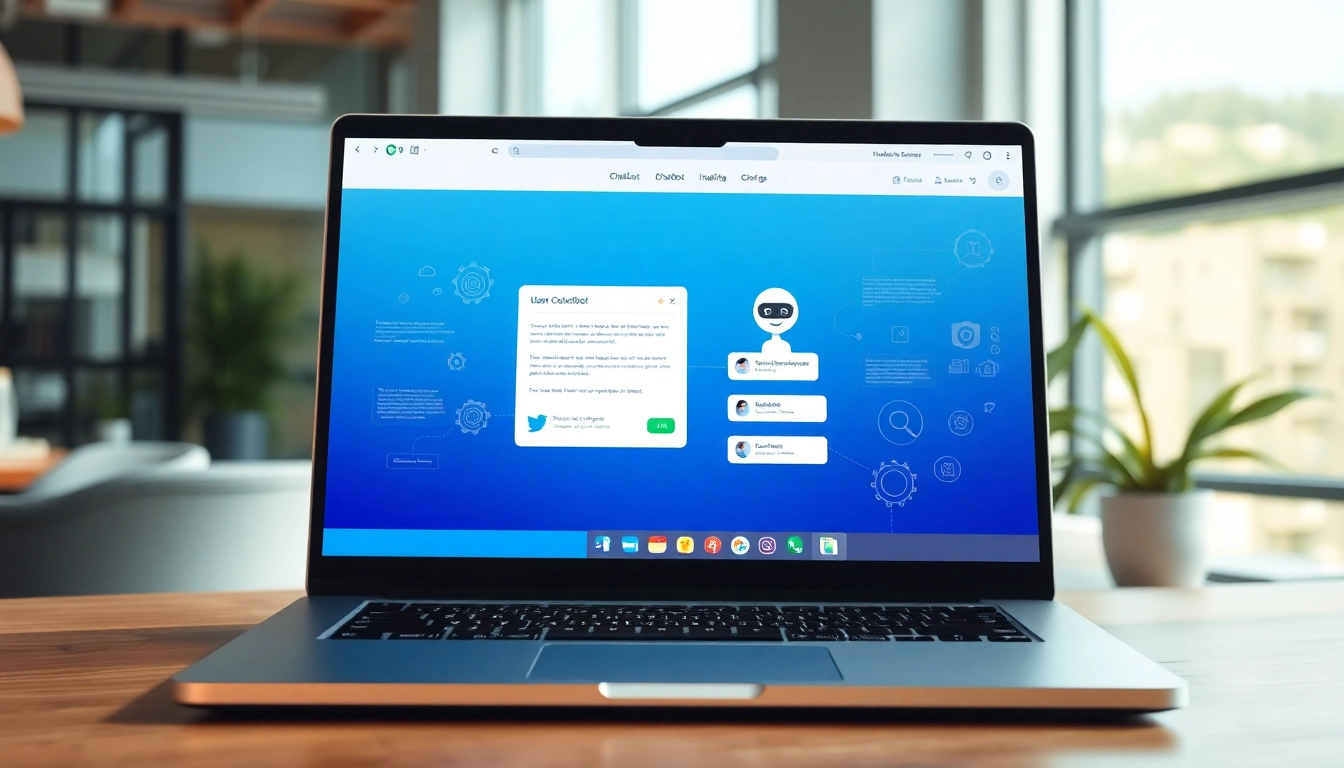Understanding AI Chatbots for Websites
What Is an AI Chatbot?
An AI chatbot is a sophisticated software application designed to simulate human-like conversations with users. Utilizing natural language processing (NLP) and machine learning capabilities, these chatbots can understand and respond to user queries in real time. The integration of an AI chatbot into a business’s website allows for automated interaction with visitors, making it a pivotal tool in today’s digital landscape. Essentially, AI chatbots serve as the first point of contact for customer service, guiding users through their journey seamlessly.
How AI Chatbots Enhance User Experience
The user experience can be significantly enhanced by employing AI chatbots for websites. One of the primary advantages is their ability to provide instant responses to inquiries, thereby reducing wait times that may frustrate users. This immediate feedback helps in lowering bounce rates and improves overall satisfaction. Furthermore, chatbots can engage users by personalizing interactions based on previous behavior and preferences, thus creating a more tailored experience. By integrating an AI chatbot for website, businesses can increase user engagement and foster lasting relationships.
Key Features of Effective AI Chatbots
The effectiveness of an AI chatbot largely hinges on its features. Several key features contribute to a robust chatbot experience:
- Natural Language Processing: The ability to understand and interpret human language, allowing users to communicate as they would naturally.
- Personalization: Utilizing user data to personalize interactions, ensuring relevance and enhancing user satisfaction.
- Multi-Channel Support: The capability to operate across various platforms, including websites, social media, and messaging apps.
- Data Analytics: Gathering insights from user interactions to help businesses understand customer needs and improve service offerings.
- Seamless Integration: The ease with which the chatbot can integrate with existing systems and third-party applications enhances its operational effectiveness.
Benefits of Implementing an AI Chatbot for Your Website
Improved Customer Service
One of the most compelling benefits of deploying an AI chatbot is improved customer service. By providing instantaneous answers to customer inquiries, businesses can enhance their service quality significantly. AI chatbots ensure that users receive 24/7 assistance, which is not feasible with conventional customer service methods. This consistent availability helps satisfy customer needs promptly, leading to increased loyalty and trust in the brand.
Increased Conversion Rates
The presence of an AI chatbot can substantially boost conversion rates. By engaging users in conversation, chatbots can guide them through the sales funnel, addressing any concerns they may have that could impede purchasing decisions. Through strategic upselling and cross-selling during interactions, chatbots can influence users to make purchases they might not have considered otherwise, thereby directly impacting the bottom line.
24/7 Availability and Support
With an AI chatbot, businesses can offer round-the-clock support to their customers. This capability is particularly beneficial for e-commerce sites where customers may be shopping at all hours. Having a dedicated assistant available at all times means that questions can be answered, and problems can be resolved immediately, regardless of time zone.
Choosing the Right AI Chatbot Solution
Factors to Consider
Selecting the right AI chatbot solution requires careful consideration of various factors. Some essential aspects to evaluate include:
- Purpose: Identify the primary function of the chatbot—whether it’s for customer service, sales, or general inquiries.
- Integration Capability: The chatbot should seamlessly integrate with existing platforms like CRM systems and e-commerce solutions.
- Budget: Assess the cost versus the benefits the chatbot will provide, ensuring it aligns with your financial capabilities.
- Scalability: Look for a solution that can grow with your business as your needs change over time.
Comparing Popular AI Chatbot Providers
When it comes to AI chatbots, various providers offer unique features catering to different business needs. Some of the most popular solutions include:
- Chatfuel: Known for its user-friendly interface, Chatfuel allows businesses to create chatbots without any coding knowledge.
- ManyChat: Built primarily for marketing on social media, ManyChat offers automation tools that help businesses engage with their audience effectively.
- Zendesk Chat: Ideal for customer support, Zendesk integrates seamlessly with its other customer service tools, enhancing overall functionality.
- Intercom: Offers robust features for lead generation and customer support, leveraging powerful analytics to improve user interactions.
Customizability and Integration Options
Choosing a chatbot solution with strong customizability and integration capabilities is crucial. The ability to personalize the chatbot’s responses and appearance can make a significant difference in user engagement. Furthermore, integration with APIs and existing platforms can enhance the chatbot’s functionality, allowing it to access user data and deliver more effective responses. Seek providers that offer customization options, such as branded chat interfaces and adjustable conversational flows, to maintain consistency with your brand identity.
Best Practices for Deploying an AI Chatbot on Your Website
Designing an Engaging Chat Interface
The design of the chat interface plays a vital role in the effectiveness of a chatbot. A well-designed chat interface should be intuitive and visually appealing. Consider using familiar elements such as buttons and quick replies to facilitate user interaction. Additionally, employing an approachable tone and conversational language can put users at ease and encourage them to engage more fully. Incorporating branding elements such as logo and colors ensures that the chatbot aligns with the overall aesthetics of your website.
Creating a Knowledge Base for Responses
Establishing a comprehensive knowledge base is critical for an AI chatbot’s success. A knowledge base consists of a well-organized repository of information that the chatbot can reference to answer user inquiries accurately. This resource should include FAQs, product details, and troubleshooting guides. Regularly updating the knowledge base as products, services, or business practices change will ensure the chatbot remains relevant and helpful to users.
Monitoring and Analyzing Chatbot Performance
After deploying a chatbot, continuous monitoring and analysis are vital for ongoing improvement. Implementing metrics to assess chatbot performance—such as user engagement rates, average response times, and user satisfaction scores—can provide valuable insights. Analyzing data helps identify areas for enhancement, such as necessary adjustments in conversation scripts or additional information for the knowledge base, ultimately leading to a better user experience.
Case Studies: Successful AI Chatbots in Action
Industry Examples of Effectiveness
Several industries have successfully leveraged AI chatbots to enhance customer interactions:
- Retail: The clothing brand H&M utilizes a chatbot that guides users through their shopping experience, helping them find items based on their preferences and offering style tips.
- Travel: Kayak’s chatbot assists users in finding flights, hotels, and travel itineraries quickly, streamlining the planning process.
- Finance: Bank of America’s Erica chatbot helps customers manage their accounts, make transactions, and provides personalized financial insights.
Lessons Learned from Leading Brands
Successful implementations of AI chatbots often share key lessons that can inform future strategies. For instance:
- Continuous Improvement: Many organizations emphasize the need for ongoing training and tweaks to the chatbot based on user feedback and interaction data.
- User-Centric Approach: Focusing on user intent and behavior enhances the overall effectiveness of the chatbot.
- Integration is Key: Successful chatbots that blend seamlessly with existing systems yield better results, as they provide users with comprehensive support.
Measuring Impact and ROI
Quantifying the return on investment (ROI) of an AI chatbot can be achieved through various metrics. The impact on customer satisfaction scores, reduction in operational costs, and increases in sales conversions are significant indicators. Regularly collecting data concerning the chatbot’s performance against these metrics allows businesses to gauge its effectiveness and strategize for future enhancements. Analyzing this data ensures that the chatbot continues to deliver value over time.




